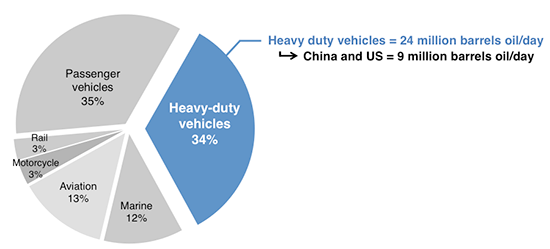Blog
China, US collaborate to deliver the goods with efficient trucks
It’s not often that heads of state and top foreign ministers talk about the fuel economy of big rigs, 18-wheelers, tractor-trailers, etc. In fact, the environmental prospects for cleaning up heavy-duty vehicles have seldom been mentioned by government leaders. That is, until now.
Last week, high-level US and China officials met to discuss climate, and the talks were quite successful, producing a joint statement that they would work together to tackle some of the toughest climate problems related to cleaner transportation and a cleaner power grid. That statement follows hard on the heels of statement by President Obama’s speech outlining his administration’s climate action plan, which seeks to reduce vehicle- and power-related emissions. In other words, the highest-level policymakers in the two largest national economies—and largest carbon emitters—are talking about major technical collaboration, major emission reduction action, and major reductions in oil use in their nations’ truck fleets. A noteworthy detail in the announcement by the China-US Climate Working Group is that the governments would emphasize not only carbon dioxide but also black carbon, which currently is not regulated by any government agency (although it is the number two climate forcing pollutant). It seems that energy and climate policy in the US and China have turned away from the sluggishness of ten years ago to a progressive collaboration that will be quite exciting to track in years ahead.
There are good reasons for the Climate Working Group to focus on trucks. Heavy-duty vehicle activity (including freight trucks and buses) has long been a critical part of the economy, and now it is a major, growing contributor to greenhouse gas emissions (such as carbon dioxide) and petroleum use. As my colleague recently pointed out, trucks are a prime target for new climate mitigation policy. As most of the major markets implement passenger vehicle efficiency standards (see our global summary here), heavy-duty vehicles account for a large and increasing share of transportation oil consumption and carbon emissions. Based on the ICCT’s modeling, while passenger vehicles are at present the largest contributor of transportation carbon emissions, by 2030 heavy-duty vehicles could match their energy consumption, and hence emissions, globally. By 2030, according to present trends, heavy-duty vehicles will consume about 24 million barrels of oil equivalent per day (up from about 16 million today), accounting for over a third of transportation’s energy use and about 4.6 billion tons of CO2 per year. China and the US are, and will continue to be, the largest heavy-duty vehicle markets through 2030, responsible for a combined 39% of the world’s heavy-duty vehicle energy use.

Transportation energy use in 2030
For policy background, both the US and China already have developed foundational regulatory standards for medium- and heavy-duty engines and vehicles (see our regulation summaries for the US and China). These initial efficiency standards have a number of important omissions: their ability to push advanced hybrid and transmission technology is limited; they neglect trailer designSuperTruck. And the US and China standards also could more consistently and fully promote technologies across all vehicle segments. So improving on the existing US and China standards for 2020 and beyond will be an important and challenging task.
The potential for improvement from new trucks in the US and China is enormous. Just in these two markets, it could be possible by 2030 to reduce emissions by 270 million tons CO2 per year and to cut trucks’ oil use by over 1.3 million barrels per day through long-term regulatory standards that push feasible technologies into the marketplace in the next rounds of heavy-duty vehicle standards. All of this signals a very exciting time for the engine manufacturers, suppliers, and truck manufacturers who develop and deploy the technologies to more efficiently deliver the goods. The US and China are looking to be leaders in these efficiency technologies, and the recent government announcements are an excellent step in that direction.
